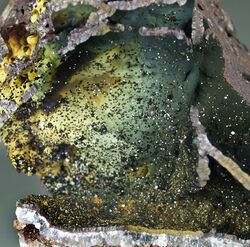Chemistry:Corkite
From HandWiki
Short description: Phosphate mineral
| Corkite | |
|---|---|
 | |
| General | |
| Category | Phosphate minerals |
| Formula (repeating unit) | PbFe3[(OH)6:SO4:PO4] |
| Strunz classification | 8.BL.05 |
| Dana classification | 43.4.1.2 |
| Crystal system | Trigonal |
| Crystal class | Ditrigonal pyramidal (3/m) (same H-M symbol) |
| Space group | R3m |
| Unit cell | a = 7.3065(5) Å, c = 16.897(2) Å; V = 781.2 ų; Z = 3 |
| Identification | |
| Formula mass | 667.82 g/mol |
| Color | Brown to light yellowish brown, pale yellow, yellowish green to dark green |
| Crystal habit | Crystals pseudocubic rhombohedral with prominent {1011}. Commonly in crusts and massive |
| Cleavage | Perfect on {0001} |
| Mohs scale hardness | 3.5–4.5 |
| |re|er}} | Vitreous, resinous |
| Diaphaneity | transparent |
| Specific gravity | 4.295 (measured), 4.31 (calculated) |
| Optical properties | Uniaxial (−), may appear anomalously biaxial |
| Refractive index | nω = 1.930 nε = 1.930 n = 1.93 – 1.96 |
| Birefringence | δ = 0.000 |
| Other characteristics | Readily soluble in warm HCl |
| References | [1][2][3][4][5] |
Corkite is a phosphate mineral in the beudantite subgroup of the alunite group. Corkite is the phosphate analogue of beudantite and with it, a complete solid solution range exists. Corkite will also form a solid solution with kintoreite.
Corkite is named after County Cork, Ireland; the location where the first notable amount was discovered in 1869.[2] Like many of the other minerals in the beudantite group, corkite is a relatively uncommon, secondary mineral that occurs in oxidation zones near hydrothermal base metal deposits.[2] It occurs associated with pyromorphite, malachite, plumbojarosite, limonite and quartz.[5]
References
- ↑ Mineralienatlas
- ↑ 2.0 2.1 2.2 Mindat.org http://www.mindat.org/min-1130.html
- ↑ Webmineral.com http://webmineral.com/data/Corkite.shtml
- ↑ EuroMin.net http://euromin.w3sites.net//mineraux/CORKITE.html
- ↑ 5.0 5.1 "Handbook of Mineralogy". http://www.handbookofmineralogy.com/pdfs/corkite.pdf.
- ↑ Warr, L.N. (2021). "IMA–CNMNC approved mineral symbols". Mineralogical Magazine 85 (3): 291–320. doi:10.1180/mgm.2021.43. Bibcode: 2021MinM...85..291W.
 |

